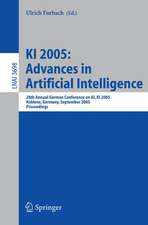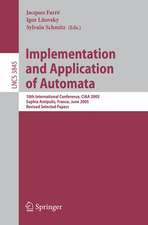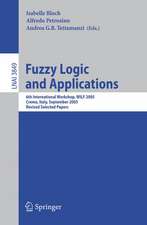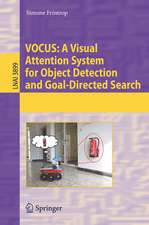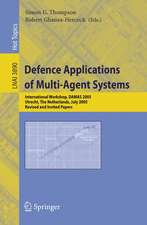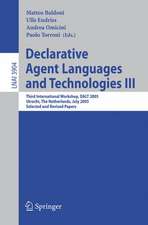Knowledge Engineering: Unifying Knowledge Base and Database Design: Artificial Intelligence
Autor John Debenhamen Limba Engleză Paperback – 13 dec 2011
Din seria Artificial Intelligence
-
 Preț: 78.18 lei
Preț: 78.18 lei - 8%
 Preț: 218.19 lei
Preț: 218.19 lei -
 Preț: 78.18 lei
Preț: 78.18 lei -
 Preț: 78.18 lei
Preț: 78.18 lei - 20%
 Preț: 724.25 lei
Preț: 724.25 lei - 20%
 Preț: 721.65 lei
Preț: 721.65 lei - 20%
 Preț: 719.60 lei
Preț: 719.60 lei - 23%
 Preț: 654.44 lei
Preț: 654.44 lei - 20%
 Preț: 365.80 lei
Preț: 365.80 lei - 20%
 Preț: 324.64 lei
Preț: 324.64 lei - 20%
 Preț: 342.28 lei
Preț: 342.28 lei - 20%
 Preț: 659.97 lei
Preț: 659.97 lei - 20%
 Preț: 330.24 lei
Preț: 330.24 lei - 20%
 Preț: 641.01 lei
Preț: 641.01 lei - 20%
 Preț: 555.53 lei
Preț: 555.53 lei - 20%
 Preț: 375.15 lei
Preț: 375.15 lei - 20%
 Preț: 331.58 lei
Preț: 331.58 lei - 20%
 Preț: 661.47 lei
Preț: 661.47 lei - 20%
 Preț: 1006.48 lei
Preț: 1006.48 lei - 20%
 Preț: 647.79 lei
Preț: 647.79 lei - 15%
 Preț: 638.89 lei
Preț: 638.89 lei - 20%
 Preț: 1001.16 lei
Preț: 1001.16 lei - 20%
 Preț: 834.69 lei
Preț: 834.69 lei - 20%
 Preț: 326.46 lei
Preț: 326.46 lei - 20%
 Preț: 757.48 lei
Preț: 757.48 lei - 20%
 Preț: 642.19 lei
Preț: 642.19 lei - 20%
 Preț: 328.27 lei
Preț: 328.27 lei - 20%
 Preț: 339.99 lei
Preț: 339.99 lei - 20%
 Preț: 342.96 lei
Preț: 342.96 lei - 20%
 Preț: 648.44 lei
Preț: 648.44 lei - 20%
 Preț: 657.99 lei
Preț: 657.99 lei - 20%
 Preț: 330.42 lei
Preț: 330.42 lei - 20%
 Preț: 654.55 lei
Preț: 654.55 lei - 20%
 Preț: 656.03 lei
Preț: 656.03 lei -
 Preț: 394.29 lei
Preț: 394.29 lei - 20%
 Preț: 652.73 lei
Preț: 652.73 lei - 20%
 Preț: 1051.00 lei
Preț: 1051.00 lei - 20%
 Preț: 338.81 lei
Preț: 338.81 lei - 20%
 Preț: 709.98 lei
Preț: 709.98 lei - 20%
 Preț: 344.93 lei
Preț: 344.93 lei - 20%
 Preț: 650.27 lei
Preț: 650.27 lei - 20%
 Preț: 639.35 lei
Preț: 639.35 lei
Preț: 654.70 lei
Preț vechi: 818.37 lei
-20% Nou
Puncte Express: 982
Preț estimativ în valută:
125.27€ • 131.15$ • 103.66£
125.27€ • 131.15$ • 103.66£
Carte tipărită la comandă
Livrare economică 05-19 aprilie
Preluare comenzi: 021 569.72.76
Specificații
ISBN-13: 9783642720369
ISBN-10: 3642720366
Pagini: 484
Ilustrații: XIV, 466 p.
Dimensiuni: 155 x 235 x 25 mm
Greutate: 0.67 kg
Ediția:Softcover reprint of the original 1st ed. 1998
Editura: Springer Berlin, Heidelberg
Colecția Springer
Seria Artificial Intelligence
Locul publicării:Berlin, Heidelberg, Germany
ISBN-10: 3642720366
Pagini: 484
Ilustrații: XIV, 466 p.
Dimensiuni: 155 x 235 x 25 mm
Greutate: 0.67 kg
Ediția:Softcover reprint of the original 1st ed. 1998
Editura: Springer Berlin, Heidelberg
Colecția Springer
Seria Artificial Intelligence
Locul publicării:Berlin, Heidelberg, Germany
Public țintă
ResearchCuprins
1 Fundamentals.- 1.1 Introduction.- 1.2 Formalisms.- 1.3 Data, information and knowledge.- 1.4 Knowledge-based systems.- 1.5 Summary.- 2 Non-unified design.- 2.1 Introduction.- 2.2 Non-unified methodology.- 2.3 Non-unified representation.- 2.4 Classification.- 2.5 Representation.- 2.6 Specification.- 2.7 Summary.- 3 Items.- 3.1 Introduction.- 3.2 Unified representation.- 3.3 Item structure.- 3.4 Data items.- 3.5 Information items.- 3.6 Knowledge items.- 3.7 Algebra of items.- 3.8 System items.- 3.9 Summary.- 4 Objects.- 4.1 Introduction.- 4.2 Limitations of items.- 4.3 Object structure.- 4.4 Data objects.- 4.5 Information objects.- 4.6 Knowledge objects.- 4.7 Algebra of objects.- 4.8 Inheritance.- 4.9 Summary.- 5 Schemas.- 5.1 Introduction.- 5.2 i-schemas.- 5.3 r-schemas.- 5.4 From r-schemas to i-schemas.- 5.5 o-schemas.- 5.6 o-schemas as operators.- 5.7 t-schemas.- 5.8 Summary.- 6 Normalisation.- 6.1 Introduction.- 6.2 Meaning of normal.- 6.3 Normalisation of items.- 6.4 Normalisation of objects.- 6.5 Classical normal forms.- 6.6 Non-classical normal forms.- 6.7 Normal forms for groups.- 6.8 Summary.- 7 Specification.- 7.1 Introduction.- 7.2 Methodology structure.- 7.3 Item behaviour.- 7.4 r-schema construction.- 7.5 Application representation.- 7.6 Requirements identification.- 7.7 Summary.- 8 Analysis.- 8.1 Introduction.- 8.2 Conceptual model.- 8.3 Basis.- 8.4 Conceptual view.- 8.5 c-coupling map.- 8.6 Constraints.- 8.7 Summary.- 9 Function.- 9.1 Introduction.- 9.2 Functional model.- 9.3 Analysis of transactions.- 9.4 Functional view.- 9.5 f-coupling map.- 9.6 Constraints.- 9.7 System function problem.- 9.8 Summary.- 10 Layout.- 10.1 Introduction.- 10.2 Internal model.- 10.3 Operational requirements.- 10.4 Internal view.- 10.5 i-coupling map.- 10.6 Constraints.- 10.7System layout problem.- 10.8 Summary.- 11 Maintenance.- 11.1 Introduction.- 11.2 Methodology.- 11.3 Set constraints.- 11.4 Strategy for maintenance.- 11.5 Significance of normalisation.- 11.6 System constraints.- 11.7 Management of maintenance.- 11.8 Summary.- 12 Case study.- 12.1 Introduction.- 12.2 Requirements specification (1).- 12.3 Analysis (1).- 12.4 Function (1).- 12.5 Second prime r-schema.- 12.6 Layout.- 12.7 Maintenance.- References.
Textul de pe ultima copertă
This book is a systematic and detailed description of a design methodology for knowledge-based systems. Such systems contain knowledge as well as information and data. The information and data can be modeled and implemented as a database, the knowledge can be implemented either in a programming language or in an expert systems shell. The methodology has two special features: It is unified, i.e., it represents the data, information, and knowledge in a homogeneous manner, as well as the relationships between them. Also, it builds a maintenance mechanism into the design.
An additional benefit of the book is its thorough treatment of constraints for knowledge and for knowledge-based systems. Presenting the material in both a formal and a practical way, it is intended for practitioners as well as researchers and advanced students.
An additional benefit of the book is its thorough treatment of constraints for knowledge and for knowledge-based systems. Presenting the material in both a formal and a practical way, it is intended for practitioners as well as researchers and advanced students.
Caracteristici
A systematic and detailed presentation of a design methodology for knowledge-based systems Data, information, and knowledge are integrated in a unified methodology The methodology builds a maintenance mechanism into the design











